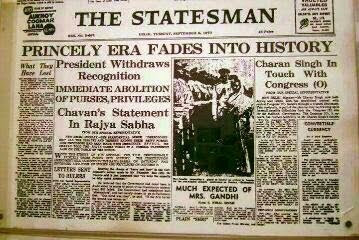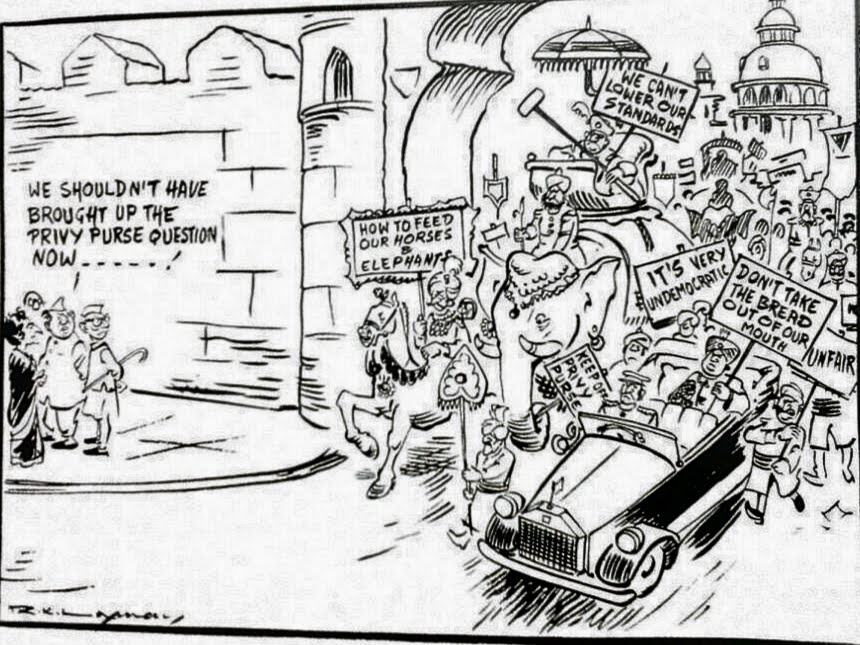37 | Privy Purses: Origins, Abolition and Impact
- indiastatestories
- Sep 4
- 7 min read
Updated: Sep 11
A privy purse was an annual fixed amount of money promised to the rulers of the former princely states in India following their integration into the Indian Union after independence in 1947. As part of this ‘historic settlement’, rulers entered into covenants and agreements with the Indian state upon signing the Instrument of Accession. These agreements guaranteed the rulers several provisions, including privy purses, succession to the gaddi (throne), rights and privileges, and full ownership of their private properties (Dhabhai 2018).
“It was a small price for the bloodless revolution.”
— Sardar Patel
Background
This concept of providing financial support or pensions to rulers who surrendered their territories had historical roots in the British period. The British Government, during the process of establishing its empire, set a precedent by giving liberal pensions to rulers. The Government of India continued to honour some of these commitments. These settlements were viewed as consideration for the surrender by the rulers of all their ruling powers and for the dissolution of their States as separate units. The amount was an annual fixed sum, determined in consultation with bodies like the Indian States' Finances Enquiry Committee, and was considered political in nature, compensating for the ‘economic benefits’ of integrating the princely states.
Although some leaders congratulated Sardar Patel for securing ‘almost the minimum possible’ amounts, Jawaharlal Nehru held a more ambivalent view towards the privy purses than Patel. He initially opposed their inclusion in the constitution, as he considered these large payments unjustified in the democracy where masses were struggling. In 1953 & 1954, he wrote to princes, urging them to voluntarily contribute portions of their privy purses for developmental schemes or invest in national loans. Despite his personal reservations, he conceded that the government had to abide by them due to prior assurances and agreements. Mahatma Gandhi had greater affinity towards princes than Nehru or Patel. He viewed the grant of the privy purses as the ‘elementary justice’ for the rulers who had signed away their territories (Zubrzycki, 2023).
Notable Privy Purse negotiations
Kathiawar states (Saurashtra Union): The Kathiawar states, being generally small and resource-poor, demanded for higher amounts, arguing for 20% of their gross revenues and additional provisions for ceremonies, citing their unique cost of living and prestige. VP Menon firmly stressed that it cannot go beyond a maximum value of Rs. 10 lakh. He ultimately agreed to the "Deccan States formula," which provided 15%. The scale of privy purses granted to Kathiawar rulers was notably higher than to other rulers in India.
Orissa States: These states, despite sitting on mineral and coal deposits, were generally poor. The rulers requested a bicameral legislature, perpetual privy purses fixed on a uniform basis. Menon was accommodating on most points requested by the rulers, except for the privy purses. They became the blue-print for other states’ privy purse calculations and merger agreements.
Gwalior and Indore: These were major states where it was difficult to find a solution for privy purses based on the Rs 10 lakh limit, as their rulers were already drawing significantly higher amounts (Gwalior: Rs 32 lakh, Indore: Rs 18 lakh), often fixed by their own legislatures. The rulers argued that since they were voluntarily merging viable states, they should not be treated less favourably than states that held out. After extensive discussion, Gwalior's privy purse was fixed at Rs 25 lakh and Indore's at Rs 15 lakh.
Bhopal: The Nawab of Bhopal was a prominent figure in the Chamber of Princes, and his state held a key position in central India. The negotiations with him were prolonged and his privy purse was settled at Rs 11 lakh, with Rs 1 lakh specifically for his eldest daughter, the heir apparent. The Nawab was initially reluctant to hand over his jagirs (land grants), but he ultimately agreed to resume them after appealing to Sardar Patel's decision.
Baroda: Gaekwar Pratap Singh of Baroda was known for his ostentatious lifestyle and princely excesses. He attempted to extract a collateral letter from Sardar Patel regarding no financial liabilities, which Patel ignored. After Menon’s negotiations, which highlighted the inability of the state to survive on its own, Pratap Singh signed the merger agreement. His privy purse was fixed at Rs 26.5 lakh. Menon also secured promises for the return of smuggled jewels and the creation of a trust for his personal property.
Mysore: The privy purse and private properties of the Maharajah of Mysore were settled in unusual circumstances, with Sardar Patel expressing anxiety about the unresolved matter. Menon travelled to Mysore and concluded discussions in three days, settling the Maharajah's privy purse at Rs 26 lakh.
Constitutional Provisions and Legal Developments on Privy Purses
When these provisions were discussed in the Constituent Assembly in 1949–1950, they were generally accepted. These were part of the political agreements during accession, offering guarantees and financial support to former rulers in recognition of their cooperation in the nation-building process. The total annual privy purse liability was Rs 580 lakh (Menon, 1956).
Initially, the payments were to come from the respective states’ revenues. However, after integration, the Central Government took over the liability, on the grounds that they were fixed by the Centre and they were political in nature. Article 291 of the Constitution guaranteed that privy purses would be paid from the Consolidated Fund of India, and Article 362 protected the privileges and rights of rulers. Article 366(22) defined a ‘ruler’ as one recognized by the President of India (Menon, 1956).
The amounts of the privy purses were determined based on the Eastern States formula, which calculated the amount as a percentage of the average revenues of the State. The financial year 1945-46 was taken as the basic year for the calculation of the Privy Purse. For larger or ‘viable’ states, the amounts sometimes exceeded standard formulas and were fixed on an ad hoc basis, often after consultation with local popular leaders or ministries (Menon, 1956). Under the terms of covenants and agreements signed by the rulers, the privy purses were to be free from taxation. This exemption was granted because the rulers were recognized as sovereigns in their respective states and were free from taxation there (White Paper, 1950).
Key States | Assured Privy Purse sum (in Rs.) |
Gwalior | 25 Lakh |
Indore | 15 Lakh |
Patiala | 17 Lakh |
Baroda | 26.5 Lakh |
Jaipur | 18 Lakh |
Jodhpur | 17.5 Lakh |
Bikaner | 17 Lakh |
Travancore | 18 Lakh |
Bhopal | 11 Lakh |
Mysore | 26 Lakh |
Hyderabad | 50 Lakh |


Dashboard: Explore the privy purse in detail here.
Abolition of Privy Purses
While initially intended to be guaranteed in perpetuity and incorporated in the constitution, the 26th Constitutional Amendment Act (1971) marked a dramatic reversal. It followed the failure of the 24th Amendment Bill (1970) in the Rajya Sabha. Following this, a Presidential order was issued on 6th September 1970, which sought to derecognize all rulers and abolish the constitutional articles [291, 362, 366(22)] that guaranteed privy purses and privileges.

In response, the rulers challenged it legally. A petition was filed by the princes, led by the Maharaja of Gwalior, against the Presidential order. It led to a landmark legal case in the Supreme Court, HH Maharajadhiraja Madhav Rao Jiwaji Rao Scindia Bahadur vs. Union of India, in 1971. In legal disputes regarding properties, they also invoked the covenants signed during the integration in the late 1940s. The Supreme Court's final judgment in the 1971 case upheld the princes' petition and declared the Presidential order abolishing the privy purses ultra vires (beyond the power of the executive) (Dhabhai, 2018).

Despite this judicial victory, the government pursued the abolition through a constitutional amendment. The government passed the 26th Amendment, which repealed Articles 291 and 362, amended Article 366(22), and added Article 363A, officially abolishing recognition of rulers and extinguishing the privy purses and privileges guaranteed to them. The government argued that the presidential order was an ‘act of state’, a sovereign political act, beyond judicial purview.

Invoking inheritance of paramountcy, it contended that rulership and privy purses were not seen as a right but ‘a gift from the President’ and a political agreement, subject to alteration according to State Policy. It also asserted that public consciousness or ‘the will of the people’ regarding social and economic rights meant the concept of rulership, privy purses, and privileges was no longer acceptable. Political motivations were also at play. The abolition is seen as a strategy by Indira Gandhi's government to dismantle the power base of the former Princes, many of whom often aligned with opposition parties like Swatantra Party and Jan Sangh (Dhabhai 2018).

Impacts of abolishing privy purses
The abolition of privy purses had several significant impacts. The process led to a shift in the status of the princes, turning them from rulers to regular citizens. While some remained influential politicians, their traditional and extraordinary status under British patronage ended (Dhabhai, 2018; Copeland, 1995).

To challenge this transition, princes formed organisations like the ‘Rulers of Indian States in Concord for India’ in 1967 to fight the abolition of privy purses and protect their heritage. However, this organisation, like the earlier Chamber of Princes, suffered from internal divisions over priorities and traditional concerns of status and rank. They also lacked real experience in lobbying politicians (Zubrzycki, 2023).

The government's postcolonial invocation of paramountcy, a colonial vestige, suggested a potential for state power beyond constitutional law, where citizens could be qualified or disqualified through political practice (Dhabhai, 2018).
It also intensified state focus and anxiety regarding the vast properties, wealth, and treasures held by former princes. The state began efforts to regulate these assets, viewing valuable items like jewellery and art treasures as ‘national wealth’ and heritage. The Antiquity and Art Treasures Act, 1972, was enacted to regulate princely wealth categorized as 'antiquity'.
In essence, the abolition of privy purses was a final chapter in dismantling the centuries old princely order. It wasn’t merely a financial decision but a symbolic declaration of India's democratic and unitary character (Zubrzycki, 2023).
References:
Copland, I. (Ed.). (1997). The princes of India in the endgame of empire, 1917-1947. Cambridge University Press.
Dhabhai, G. (2020). Paramount State and the ‘Princely Subject’: Privy Purses Abolition and Its Aftermath. In A. Roy & M. Becker (Eds.), Dimensions of Constitutional Democracy (pp. 169–181). Springer Singapore. https://doi.org/10.1007/978-981-15-3899-5_9
Menon, V. P. (1956). The Story of Integration of the Indian states. Orient Blackswan.
Ministry of States, (1950). White Paper on Indian States. https://en.wikisource.org/wiki/White_Paper_on_Indian_States_(1950)
Zubrzycki, J. (2023). Dethroned: Patel, Menon and the integration of Princely India. Juggernaut Books.



Comments